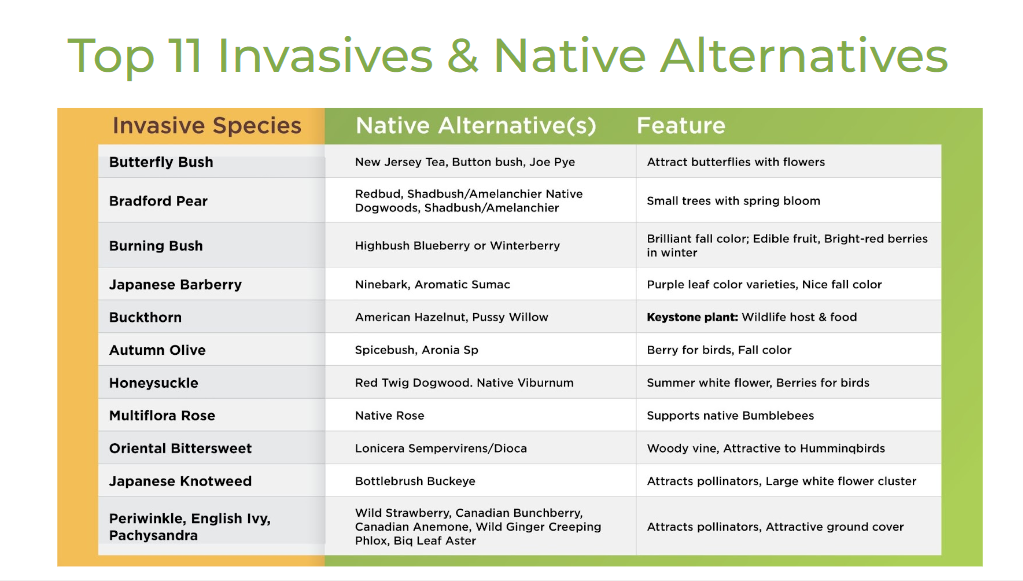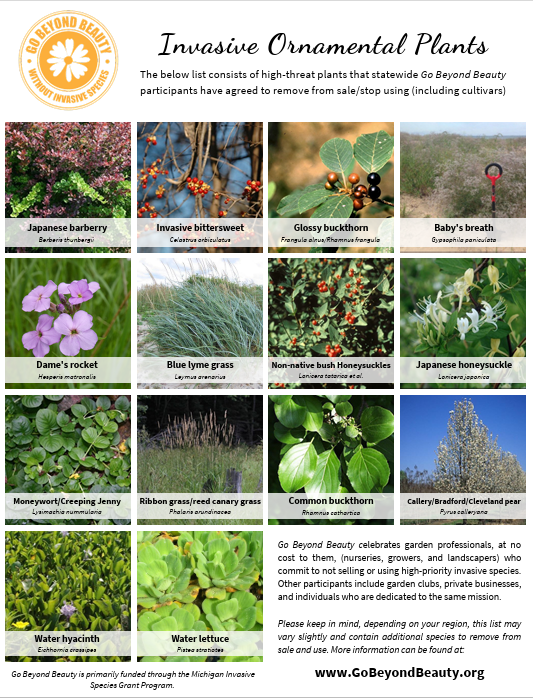Definitions:
Invasive species are “a species that is non-native to the ecosystem under consideration and whose introduction causes or is likely to cause economic or environmental harm or harm to human health.”
Non-native species are those that did not occur in Michigan’s ecological communities prior to widespread European settlement.
Aggressive species are those that are native to Michigan’s ecological communities but may grow vigorously enough to crowd out other plants in the right conditions.
Guide with Images for identification: InvasivePlantsFieldGuide.pdf (msu.edu)
MISIN – Michigan Invasive Species Information Network to report Invasives and use the MISIN App
Local events for Invasive Control:
CISMAs: Managing invasive species near you – Oakland County CISMA
Check out the recent Invasive Species Summit info
Dealing with Invasives
- Lesser Celadine (Ranunculus ficaria/Ficaria verna)
- Phragmites australis – Great Lakes Phragmites Collaborative
GO Beyond Beauty Program:
These 14 plants are still in the nursery trade, please do not purchase and ask the nursery to quit selling. Raise awareness that these plants are causing harm to our natural areas, even though they have not made it to the Restricted/Prohibited plants in Michigan. Ask your local municipalities to bar any new purchases of these plants and remove any existing.
The below list consists of high-threat plants that Go Beyond Beauty participants have agreed to remove from sale/stop using (including cultivars).
TOP REPORTED INVASIVE SPECIES
- Phragmites (Invasive): 58,985
- Garlic mustard: 15,723
- Brown marmorated stink bug: 12,258
- Japanese knotweed: 11,353
- Autumn olive: 11,267
- Spotted knapweed: 9,407
- Purple loosestrife: 7,097
- European frog-bit: 6,145
- Bush honeysuckle: 6,106
- Japanese barberry: 5,450
Delaware recently banned the sale of many more plants. These should be considered suspect in Michigan as well. See this list below.
Based on the expert assessments, an I-Rank, or invasive rank was determined based on expert responses denoting the level at which a species is invasive in the identified geographic area, in this case, the state of Delaware. These ranks are categorized by high, medium, low, and insignificant. If a species was ranked as high, medium, or low, they are deemed invasive to some degree by the experts and; therefore, are included in the current iteration of the DISC list of Invasive Plant Species. Species ranked as insignificant, were added to the DISC Watch List and will be reevaluated in two years when the list will again be revised. Additionally, for future revisions to the list, selected species thought to be invasive in Delaware will also be evaluated. In contrast to the 2006 DISC list of invasive plants, the new list includes only two categories – invasive and watch list. Below are the results.
DISC Invasive Plant List
| Species | Common Name |
| Acer palmatum | Japanese maple |
| Acer platanoides | Norway maple |
| Acorus calamus | European sweetflag |
| Ailanthus altissima | Tree of heaven |
| Alliaria petiolata | Garlic mustard |
| Ampelopsis glandulosa | Porcelain berry |
| Berberis thunbergii | Japanese barberry |
| Celasrus orbiculatus | Oriental bittersweet |
| Centaurea stoebe subsp. micranthos | Spotted knapweed |
| Clematis terniflora | Japanese Clematis |
| Elaeagnus umbellata | Autumn olive |
| Eragrostis curvula | Weeping lovegrass |
| Euonymus alatus | Winged euonymus – Burning Bush |
| Euonymus fortunei | Wintercreeper |
| Fallopia japonica | Japanese knotweed |
| Ficaria verna | Lesser celandine |
| Hedera helix | English ivy |
| Hemerocallis fulva | Orange daylily |
| Hydrilla verticillata | Hydrilla |
| Iris pseudacorus | Yellow flag iris, Water flag |
| Koelreuteria paniculata | Golden raintree |
| Leucojum aestivum | Summer snowflake |
| Ligustrum vulgare | European privet |
| Lonicera japonica | Japanese honeysuckle |
| Lonicera maackii | Amur honeysuckle |
| Lonicera morrowii | Morrow’s honeysuckle |
| Lonicera tatarica | Tartarian honeysuckle |
| Lysimachia nummularia | Creeping Jenny |
| Lythrum salicaria | Purple loosestrife |
| Microstegium vimineum | Japanese stilt grass |
| Miscanthus sinensis | Chinese silvergrass |
| Murdannia keisak | Marsh Dewflower |
| Pachysandra terminalis | Japanese pachysandra |
| Persicaria perfoliata | Mile-a-minute |
| Phalaris arundinacea | Reed canarygrass |
| Phragmites australis subsp. australis | European reed |
| Pinus thunbergiana | Japanese black pine |
| Pyrus calleryana | Callery pear |
| Rosa multiflora | Multiflora rose |
| Rubus phoenicolasius | Wineberry |
| Viburnum dilatatum | Linden arrowwood |
| Viburnum sieboldii | Siebold’s viburnum |
| Vinca minor | Lesser periwinkle |
| Wisteria sinensis | Chinese wisteria |
DISC Invasive Plant Watch List
| Species | Common Name |
| Buddleja davidii | Butterflybush |
| Ilex crenata | Japanese holly |
| Lespedeza thunbergii | Thunberg’s bushcover |
| Lilium lancifolium | Tiger lily |
| Lotus corniculatus | Bird’s foot trefoil |
| Mahonia bealei | Leatherleaf mahonia |
| Quercus acutissima | Sawtooth oak |
| Spirea japonica | Japanese spirea |
| Viburnum plicatum | Japanese snowball |
| Viburnum setigerum | Tea viburnum |
Replacing Common Invasive Ornamentals with Similar Natives
| Nursery Sold Invasive | Native Alternative(s) | Feature |
| Bradford Pear | Redbud, Native Dogwoods, Shadbush/Amelanchier | Small trees with spring bloom |
| Bamboo | Eastern red-cedar | Dense, evergreen foliage for privacy |
| Japanese or Chinese Wisteria | American Wisteria | Similar to nonnative, but not invasive |
| Burning Bush | Highbush blueberry or Winterberry | Brilliant fall color; edible fruit, Bright-red berries in winter |
| Butterfly Bush | New Jersey Tea, Button bush | Attract butterflies with flowers |
| Japanese Barberry | Ninebark, Aromatic Sumac | purple leaf color varieties, nice fall color |
| Privet | Bayberry | Glossy foliage can be pruned to hedge |
| Purple Loosestrife | Blazing-star, Joe-pye weed | Spikes of purple flowers in summer Purple flowers attract butterflies |
| Periwinkle, English Ivy, Pachysandra | Wild Strawberry, Canadian Bunchberry, Canadian Anemone, Wild Ginger, Creeping Phlox, Sedges | Attracts pollinators, Attractive groundcover |


